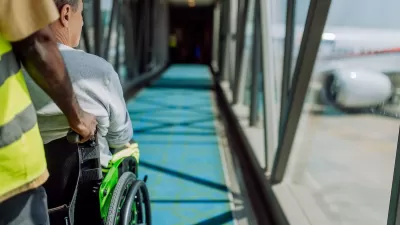Driverless cars, 'super elite" fliers, and more rail for everyone; these are among the predictions from experts for how travel in the United States will change over the next decade.
Thom Patterson reports on the expected ways in which America's traveling landscape will change over the next decade. On the roads, "we'll see amazing technological strides in the development of self-driving cars during the next decade. But America's roads and bridges will continue to suffer from much needed repairs, according to the American Society of Civil Engineers."
In the skies, "Expect more air passengers to demand Wi-Fi and personalized entertainment choices in the coming years. Airlines may provide access to movies stored on a digital media server aboard the aircraft, or, a third-party website where passengers can watch video now or later after they de-plane." But a "race to the bottom" in search of profits may create "two types of fliers: the 'haves' -- 'super-elite frequent fliers who get everything' -- and the 'have-nots' -- passengers in economy 'who get nothing,'" said airline analyst Mike Miller. Excuse us, but isn't this already the case?
Finally, more Americans will take advantage of improved rail service made possible by 2009's federal stimulus legislation, said transportation expert Yonah Freemark, who runs TransportPolitic.com. "Those investments are going to be built out and people are going to see better service on inter-city rail lines across the country," he said." And you'll see increasing ridership."
h/t Daniel Lippman
FULL STORY: 2022: Cheap flights, more rail and hands-free cars

Alabama: Trump Terminates Settlements for Black Communities Harmed By Raw Sewage
Trump deemed the landmark civil rights agreement “illegal DEI and environmental justice policy.”

Study: Maui’s Plan to Convert Vacation Rentals to Long-Term Housing Could Cause Nearly $1 Billion Economic Loss
The plan would reduce visitor accommodation by 25% resulting in 1,900 jobs lost.

Planetizen Federal Action Tracker
A weekly monitor of how Trump’s orders and actions are impacting planners and planning in America.

Wind Energy on the Rise Despite Federal Policy Reversal
The Trump administration is revoking federal support for renewable energy, but demand for new projects continues unabated.

Passengers Flock to Caltrain After Electrification
The new electric trains are running faster and more reliably, leading to strong ridership growth on the Bay Area rail system.

Texas Churches Rally Behind ‘Yes in God’s Back Yard’ Legislation
Religious leaders want the state to reduce zoning regulations to streamline leasing church-owned land to housing developers.
Urban Design for Planners 1: Software Tools
This six-course series explores essential urban design concepts using open source software and equips planners with the tools they need to participate fully in the urban design process.
Planning for Universal Design
Learn the tools for implementing Universal Design in planning regulations.
Caltrans
Smith Gee Studio
Institute for Housing and Urban Development Studies (IHS)
City of Grandview
Harvard GSD Executive Education
Toledo-Lucas County Plan Commissions
Salt Lake City
NYU Wagner Graduate School of Public Service





























